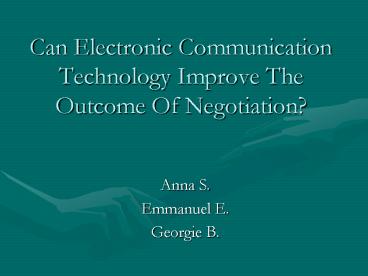Can Electronic Communication Technology Improve The Outcome Of Negotiation? - PowerPoint PPT Presentation
Title:
Can Electronic Communication Technology Improve The Outcome Of Negotiation?
Description:
Can Electronic Communication Technology Improve The Outcome Of Negotiation? Anna S. Emmanuel E. Georgie B. – PowerPoint PPT presentation
Number of Views:109
Avg rating:3.0/5.0
Title: Can Electronic Communication Technology Improve The Outcome Of Negotiation?
1
Can Electronic Communication Technology Improve
The Outcome Of Negotiation?
- Anna S.
- Emmanuel E.
- Georgie B.
2
- Technologiesare playing an increasingly
important role in decision making by facilitating
communication, collaboration, and coordination
among workers at a single as well as dispersed
locations - (Shirani et al. 1999).
3
Definitions
- Negotiation- joint decisions by parties with
different preferences (Bazerman, 2002) - Collaboration- the interaction among a number of
people to achieve a single goal or set of goals
(Collins dictionary)
4
Communication
- Communication involves the use of symbols
- (Gudykunst Kim 1984)
- Symbols NOT limited to words.
- 60 of communication nonverbal
- 2-levels of interpretation content context
- (Watzlawick, Beavin and Jackson 1967)
- Influences on effective communication
- -Feedback -Multiple cues
- (Valacich Schwenk 1995)
5
Mediums of communication
FACE-TO-FACE Synchronous communication Physical presence Abundant verbal Abundant Non- verbal social cues Tan, Bretherton, Kennedy (2004) SYNCHRONOUS COMPUTER CONFERENCING (instant messenger) Synchronous communication Lack of physical presence Diminished nonverbal social cues Lack of verbal social cues EMAIL Asynchronous communication Lack of physical presence Minimal non-verbal social cues Lack of verbal social cues
6
Face-2-face vs. Electronic
- Immediate two way flow of information
- Access to non verbal cues less potential for
misunderstandings - Personal contact TRUST
- Anonymity Extreme Unconventional Risky
decisions - (Kiesler Sproull, 1992)
- More delays
- Satisfaction
7
Face-2-face vs. Electronic continued
- Cross-border communication
- Anonymity
- History of offer exchanges
- Time
- Eliminate -ve affective cues (Carmel et al. 1993)
- Supportive software
8
Case Study
- Tan, Bretherton Kennedy (2004)
- The University of Melbourne International
Conflict Resolution Centre - Mediums of communication
- Synchronous computer conferencing
- Face-to-face
9
Case Study
- Study examined successful negotiation outcome
- 2 Styles
- -Integrative collaborative and multilateral
- -Distributive competitive and unilateral
- Hypothesis Face-to-face highest integrative
results and e-mail lowest integrative results - Method
- -Role play negotiation (N98)
- -Three groups different time frames
10
Results
Tan, Bretherton, Kennedy (2004)
11
Conclusion
- Case study suggests that the negative effects of
e-negotiation are overestimated - Richness of medium is reduced with e-negotiations
- Limitations
12
The Future
- Further developments in video-conferencing,
multiple mediums, supportive software - Context specific medium of communication
- Reducing the digital divide access for all
13
- As organisations respond to the globalisation of
markets by expanding around the world,
face-to-face communications will have to give way
to technology mediated communications. - (Moore et al, 1999)
14
References
- Bazerman, M.H. (2002). Judgement in Managerial
decision Making (5th edition). Chichester, John
Wiley Sons. - Carmel, E, Herniter, B.C. Nunamaker, J.F.
(1993) Labour-Management Contract Negotiations in
an electronic meeting room A case study, Group
Decision and Negotiation, Vol. 2, pp. 27-60. - Gudykunst, W.B. Kim, Y.Y. (1984) Communicating
with Strangers. An approach to intercultural
communication, New York, Random House. - Kiesler, S Sproull, L. (1992) Group Decision
Making and Communication Technology,
Organizational Behaviour and Human Decision
Processes, Vol. 52, pp. 96-123.
15
- Moore, D.A., Kurtzberg, T.R., Thompson, L.L.
(1999). Long and Short Routes to success in
electronically negotiations group affiliations
and good vibrations. Organisational Behaviour
and Human Decision Processes, Vol. 77, No. 1,
January, pp. 22-43. - Shirani, A.I., Tafti, M.H.A., Affisco,
J.F.(1999) Task and technology fit a comparison
of two technologies for synchronous and
asynchronous group communication. Information
Management, Vol. 36, January, pp. 139-150. - Tan, J., Bretherton, D., Kennedy, G. (2004).
Negotiating Online. - http//www.odr.info/unforum2004/tan.htm
- Valacich, J.S. Schwenk, C. (1995) Devils
Advocacy and Dialectical Inquiry Effects on
Face-to-Face and Computer-Mediated Group Decision
Making. Organizational Behavior and Human
Decision Processes, Vol. 63, No. 2, August, pp.
158-173. - Watzlawick, P., Beavin, J. and Jackson, D. (1967)
The Pragmatics of Human Communication, New York,
Norton.































